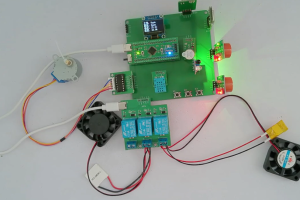设计说明书
总字数:19000+
摘要
随着道路交通的日益繁忙,酒驾行为已成为引发交通事故的重要原因之一,严重威胁着人们的生命财产安全。传统的酒驾检测主要依赖人工检查,存在效率低、随机性大、易出现漏检等问题,难以全面有效遏制酒驾行为。
基于 STM32F103C8T6 单片机的智能防酒驾设计,整合了 MQ-3 酒精传感器、BZ 红外避障管、DHT11 温湿度传感器、SU-03T 语音识别模块、独立按键、OLED 显示屏、ESP8266 WIFI 模块及执行设备(声光报警装置、继电器、制冷片、加热片、天窗控制装置等),实现了对酒驾行为的自动检测与车辆启动控制,以及车内环境的智能调节。系统核心功能包括:通过两个 MQ-3 传感器分别检测主驾驶位和副驾驶位酒精含量,当主驾驶位酒精含量大于副驾驶位且超过设定最大值时,触发声光报警,同时通过继电器禁止车辆启动;若主驾驶位酒精浓度小于副驾驶位但高于设定最大值,需触发 BZ 红外避障管进行靠近检测,若仍超标则声光报警并禁止车辆启动;通过 DHT11 检测车内温湿度,温度高于设定最大值时控制制冷片吹凉风,低于设定最小值时控制加热片吹热风;借助 SU-03T 语音识别模块,可语音控制吹冷风、热风及天窗开关;支持通过 3 个独立按键设置酒精最大值、温度上下限值,以及启动车辆、控制风类和天窗开关;通过 OLED 显示屏实时显示各项检测数据及设备状态;利用 ESP8266 WIFI 模块将数据发送至手机端,手机端可设置各阈值并远程控制风类和天窗开关。
该系统的实现,有效提升了酒驾检测的自动化与智能化水平,减少了人工干预,能及时准确地识别酒驾行为并阻止车辆启动,同时为车内环境调节提供了便捷方式,为道路交通安全提供了有力保障,也为同类车载安全设备的研发提供了参考,具有较高的实际应用价值。关键词:STM32F103C8T6;智能防酒驾;MQ-3 传感器;语音识别;WIFI 通信;安全驾驶
ABSTRACT
With the increasing busyness of road traffic, drunk driving has become one of the important causes of traffic accidents, seriously threatening people’s lives and property safety. Traditional drunk driving detection mainly relies on manual inspection, which has problems such as low efficiency, randomness, and easy missed inspection, making it difficult to comprehensively and effectively curb drunk driving.
The intelligent anti-drunk driving design based on the STM32F103C8T6 microcontroller integrates MQ-3 alcohol sensors, BZ infrared obstacle avoidance tubes, DHT11 temperature and humidity sensors, SU-03T voice recognition modules, independent buttons, OLED displays, ESP8266 WIFI modules, and executive devices (sound and light alarm devices, relays, refrigeration sheets, heating sheets, sunroof control devices, etc.), realizing automatic detection of drunk driving behavior, vehicle start control, and intelligent regulation of the in-vehicle environment. The core functions of the system include: two MQ-3 sensors detect the alcohol content of the driver’s seat and the passenger’s seat respectively. When the alcohol content of the driver’s seat is greater than that of the passenger’s seat and exceeds the set maximum value, an acousto-optic alarm is triggered, and the vehicle start is prohibited through the relay; if the alcohol concentration of the driver’s seat is less than that of the passenger’s seat but higher than the set maximum value, the BZ infrared obstacle avoidance tube needs to be triggered for proximity detection. If it still exceeds the standard, an acousto-optic alarm is given and the vehicle start is prohibited; the DHT11 detects the temperature and humidity in the car. When the temperature is higher than the set maximum value, the refrigeration sheet is controlled to blow cool air; when the temperature is lower than the set minimum value, the heating sheet is controlled to blow hot air; with the help of the SU-03T voice recognition module, it can control the blowing of cold air, hot air and the opening and closing of the sunroof by voice; it supports setting the maximum alcohol value, temperature upper and lower limits through 3 independent buttons, as well as starting the vehicle, controlling the type of wind and the opening and closing of the sunroof; the OLED display shows various detection data and equipment status in real time; the ESP8266 WIFI module sends data to the mobile phone, which can set various thresholds and remotely control the type of wind and the opening and closing of the sunroof.
The implementation of this system effectively improves the automation and intelligence level of drunk driving detection, reduces manual intervention, can timely and accurately identify drunk driving behavior and prevent the vehicle from starting, and provides a convenient way for in-vehicle environment regulation. It provides a strong guarantee for road traffic safety, and also provides a reference for the research and development of similar vehicle safety equipment, with high practical application value.
Keywords: STM32F103C8T6; Intelligent anti-drunk driving; MQ-3 sensor; Voice recognition; WIFI communication; Safe driving
目录
第 1 章 绪论
1.1 研究的目的及意义
1.2 国内外发展情况
1.3 本文主要研究内容
第2章 设计思路与方案论证
2.1 主要元器件选择
2.1.1 主控芯片选择
2.1.2 酒精传感器选择
2.1.3 红外避障模块选择
2.1.4 温湿度传感器选择
2.1.5 语音识别模块选择
2.1.6 按键模块选择
2.1.7 显示模块选择
2.1.8 WIFI 模块选择
2.2整体设计方案
第 3 章 硬件设计
3.1 主控电路模块
3.2 酒精传感器电路
3.3 红外避障模块电路
3.4 温湿度传感器电路
3.5 语音识别模块电路
3.6 显示模块电路
3.7 按键模块电路
3.8 WIFI 模块电路
3.9 执行设备驱动电路
第4章 系统程序设计
4.1 编程软件介绍
4.2 系统主流程设计
4.3 OLED显示子流程设计
4.4 独立按键子流程设计
4.5 温湿度检测模块子流程设计
4.6 ADC模数转换子流程设计
4.7 语言识别模块子流程设计
4.8 WiFi模块子流程设计
第 5 章 实物测试
5.1 整体实物测试
5.2 酒精传感器功能测试
5.3 红外避障模块功能测试
5.4 温湿度传感器功能测试
5.5 语音识别模块功能测试
5.6 WIFI 模块功能测试
5.7 按键设置与显示功能测试
第 6 章 总结与展望
6.1 总结
6.2 展望
致谢
参考文献
附录
附录一:原理图
附录二:PCB
附录三:主程序
购买后可查看具体内容!

